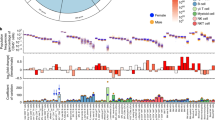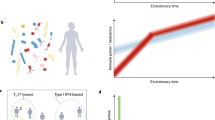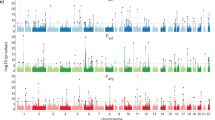Key Points
-
The identification of all mammalian genes through genome sequencing creates the possibility of understanding immune development and function in the context of the whole genome.
-
Forward-genetic strategies allow the assigning of function to gene products without previous knowledge of gene activity or expression. Importantly, many types of mutation might be uncovered, including, but not only, null alleles.
-
Chemical mutagenesis using n-ethylnitrosourea (ENU) is a robust and proven method for generating mutant animals with various immunological and other traits of interest.
-
Technological changes have made positional cloning a practical and rapid method for gene identification, including single base-pair mutations.
-
Numerous developmental and functional mutations have been identified from ENU-based screening programmes, in some cases with unexpected associations of gene and function.
-
Further exploitation of forward-genetic technologies will depend largely on the ability to screen for phenotype and function in the context of the whole animal.
Abstract
The completion of the genome sequences of both humans and mice challenges biologists to determine gene function on a vast, whole-organism scale. Both phenotype-based ('forward') and gene-based ('reverse') strategies are being developed to approach this issue. Forward-genetic approaches, however, provide the unique ability of assigning function to genes in an unbiased, global manner that is independent of previous assumptions about gene function. In this article, we compare various genetic technologies for their potential role in dissecting immune-system development and function, with particular emphasis on the worldwide efforts that use chemical mutagenesis as a forward-genetic strategy.
This is a preview of subscription content, access via your institution
Access options
Subscribe to this journal
Receive 12 print issues and online access
$209.00 per year
only $17.42 per issue
Buy this article
- Purchase on Springer Link
- Instant access to full article PDF
Prices may be subject to local taxes which are calculated during checkout




Similar content being viewed by others
References
Russ, A. et al. Random mutagenesis in the mouse as a tool in drug discovery. Drug Discov. Today 7, 1175–1183 (2002).
Samelson, L. E. Signal transduction mediated by the T cell antigen receptor: the role of adapter proteins. Annu. Rev. Immunol. 20, 371–394 (2002).
Koretzky, G. A. & Myung, P. S. Positive and negative regulation of T-cell activation by adaptor proteins. Nature Rev. Immunol. 1, 95–107 (2001).
Nadeau, J. H. et al. Sequence interpretation. Functional annotation of mouse genome sequences. Science 291, 1251–1255 (2001).
Perkins, A. S. Functional genomics in the mouse. Funct. Integr. Genomics 2, 81–91 (2002).
Sauer, B. Inducible gene targeting in mice using the Cre/lox system. Methods 14, 381–392 (1998).
Zinkernagel, R. M. & Doherty, P. C. The discovery of MHC restriction. Immunol. Today 18, 14–17 (1997).
Murphy, K. M. & Reiner, S. L. The lineage decisions of helper T cells. Nature Rev. Immunol. 2, 933–944 (2002).
Brown, S. D. & Peters, J. Combining mutagenesis and genomics in the mouse-closing the phenotype gap. Trends Genet. 12, 433–435 (1996). This paper introduces the concept of the 'phenotype gap' — the disparity between the available mouse mutant resource and the range of additional phenotypes that are required to fully exploit the mouse as a model of human disease.
Koonin, E. V., Wolf, Y. I. & Karev, G. P. The structure of the protein universe and genome evolution. Nature 420, 218–223 (2002).
Lander, E. S. et al. Initial sequencing and analysis of the human genome. Nature 409, 860–921 (2001).
Samelson, L. E. Lymphocyte activation. Curr. Opin. Immunol. 2, 210–214 (1989).
Klinghoffer, R. A., Hamilton, T. G., Hoch, R. & Soriano, P. An allelic series at the PDGFαR locus indicates unequal contributions of distinct signaling pathways during development. Dev. Cell 2, 103–113 (2002).
Vivian, J. L., Chen, Y., Yee, D., Schneider, E. & Magnuson, T. An allelic series of mutations in Smad2 and Smad4 identified in a genotype-based screen of N-ethyl-N-nitrosourea-mutagenized mouse embryonic stem cells. Proc. Natl Acad. Sci. USA 99, 15542–15547 (2002).
Perrimon, N. Signalling pathways initiated by receptor protein tyrosine kinases in Drosophila. Curr. Opin. Cell Biol. 6, 260–266 (1994).
Kornfeld, K. Vulval development in Caenorhabditis elegans. Trends Genet. 13, 55–61 (1997).
Nolan, P. M. et al. A systematic, genome-wide, phenotype-driven mutagenesis programme for gene function studies in the mouse. Nature Genet. 25, 440–443 (2000). An excellent overview of one of the first two large-scale programmes that use ethylnitrosourea (ENU).
Loy, A. L. & Goodnow, C. C. Novel approaches for identifying genes regulating lymphocyte development and function. Curr. Opin. Immunol. 14, 260–265 (2002).
Hrabe de Angelis, M. H. et al. Genome-wide, large-scale production of mutant mice by ENU mutagenesis. Nature Genet. 25, 444–447 (2000). An overview of the pioneering ENU-mutagenesis programme carried out as part of the German Human Genome Project. It accompanies reference 17, which describes a corresponding effort carried out in the United Kingdom.
Noveroske, J. K., Weber, J. S. & Justice, M. J. The mutagenic action of N-ethyl-N-nitrosourea in the mouse. Mamm. Genome 11, 478–483 (2000).
Justice, M. J. et al. Effects of ENU dosage on mouse strains. Mamm. Genome 11, 484–488 (2000).
Russell, W. L. et al. Specific-locus test shows ethylnitrosourea to be the most potent mutagen in the mouse. Proc. Natl Acad. Sci. USA 76, 5818–5819 (1979).
Flaswinkel, H. et al. Identification of immunological relevant phenotypes in ENU mutagenized mice. Mamm. Genome 11, 526–527 (2000). The first description of a large-scale ENU screen for mutations that affect the development of the immune system. This entire volume of Mammalian Genome is devoted to ENU mutagenesis.
Nelms, K. A. & Goodnow, C. C. Genome-wide ENU mutagenesis to reveal immune regulators. Immunity 15, 409–418 (2001).
Beier, D. R. ENU mutagenesis: a work in progress. Physiol. Genomics 11, 111–113 (2002).
Miosge, L. A., Blasioli, J., Blery, M. & Goodnow, C. C. Analysis of an ethylnitrosourea-generated mouse mutation defines a cell intrinsic role of nuclear factor κB2 in regulating circulating B cell numbers. J. Exp. Med. 196, 1113–1119 (2002).
Fujimoto, Y. et al. CD83 expression influences CD4+ T cell development in the thymus. Cell 108, 755–767 (2002).
Ryding, A. D., Sharp, M. G. & Mullins, J. J. Conditional transgenic technologies. J. Endocrinol. 171, 1–14 (2001).
Acknowledgements
We would like to thank M. Brunkow, G. Carlson and the Celltech ENU team.
Author information
Authors and Affiliations
Corresponding author
Related links
Related links
DATABASES
LocusLink
FURTHER INFORMATION
Glossary
- CRE–LOX TECHNOLOGY
-
A site-specific recombination system that is used to delete a gene in mouse cells using Cre recombinase. Two short DNA sequences (LoxP sites) are engineered to flank the target DNA. Expression of Cre recombinase leads to excision of the intervening sequence. Depending on the type of promoter, Cre can be expressed at specific times during development or by specific sets of cells, including embryonic stem cells.
- SINGLE TANDEM REPEATS AND SINGLE NUCLEOTIDE POLYMORPHISMS
-
(STRs and SNPs). A short series of DNA sequences (STRs) or single base-pair changes (SNPs) that are inherited in a Mendelian manner. Approximately three to six million SNPs are thought to exist in the mammalian genome and a variety of techniques are available for their specific detection.
- PHENODEVIANT
-
An animal that has a property or response outside the normal distribution for the other animals of the same pedigree. Phenodeviant animals are often presumed to result from the mutation of a specific gene, but this must be confirmed by gene identification.
- EXPRESSED SEQUENCE TAG DATABASE
-
(EST database). A database (public or private) that catalogues genes that are presumed to be expressed at the RNA level in a particular cell type or tissue.
- NON-OBESE DIABETIC MICE
-
(NOD mice). An inbred strain of mice that spontaneously develops T-cell-mediated autoimmune diabetes.
Rights and permissions
About this article
Cite this article
Appleby, M., Ramsdell, F. A forward-genetic approach for analysis of the immune system. Nat Rev Immunol 3, 463–471 (2003). https://doi.org/10.1038/nri1109
Issue Date:
DOI: https://doi.org/10.1038/nri1109
This article is cited by
-
Enterobacteria and host resistance to infection
Mammalian Genome (2018)
-
The zebrafish: a new model of T-cell and thymic development
Nature Reviews Immunology (2005)



